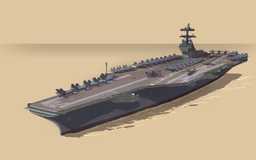Defence gamechangers / Global
Ordnance survey
From laser technology and missile deployment to regional rivalry, these are the military developments set to shape how nations make foreign policy over the coming year.

1- The next generation of warship
USA
When the first of the next-generation Ford-class ships comes onstream early next year it will mark a new era for US supercarriers. The USS Gerald R Ford, named after the 38th US president, will be able to do more than current vessels but with a smaller crew. It will reduce the operating costs of these giant floating airfields – but with a price tag of upward of $13bn (€12bn) it is the most expensive warship in history.
At 1,092 feet (333 metres) long and with a displacement of more than 100,000 tonnes, it will also be one of the largest. A crew of 4,500 will project US power around the world and relieve pressure on the overworked and ageing Nimitz-class carriers.
A new electromagnetic catapult system will replace the steam-driven versions used on all previous carriers. This should be more reliable, easier to maintain and will put less strain on aircraft taking off. The system will also be able to launch light, pilotless drones.
Carrying up to 90 aircraft, the Gerald R Ford will be able to conduct 160 sorties a day for a 30-day period, surging to 270 sorties during a crisis. It has been designed to accommodate the new F-35 Joint Strike Fighter, in addition to the FA/18 Super Hornet.
As well as new technology, the Gerald R Ford has a number of features that should make life a little more comfortable for the sailors and aircrew onboard. Wider corridors make it feel more spacious and the huge 200-person berths on the Nimitz carriers have been replaced with smaller 86-person facilities. Three gyms will be kitted out with the latest equipment.
A further nine Ford-class carriers are planned, although to date only three have been ordered. However, the programme is not universally popular at home: as China and other rivals to US power develop carrier-killing cruise missiles, critics argue that America’s tight defence budget could be better spent.
Ready for take-off
- The US navy's newest super-carrier will become operational in 2016.
- The 'Gerald R Ford' will be able to launch 160 sorties a day, surging to 270 during a crisis.
- A new electromagnetic catapult system will revolutionise the way carrier-borne aircraft are launched.
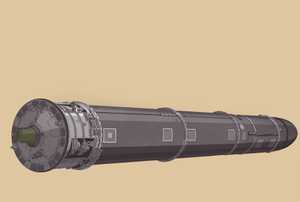
2- The new intercontinental ballistic missile in pole position
Russia
Ongoing tension with Nato states and recent commitments in Syria have pushed Russia to accelerate the development of a new intercontinental ballistic missile (ICBM). Reports from Moscow suggest that the country could conduct drop tests and flight tests of the new ICBM by the third quarter of 2016.
Known as the RS-28 Sarmat, the missile will replace the SS-18 Satan, still the world’s heaviest strategic missile. The SS-18 will be kept in service until the RS-28 is fully operational; some time between 2018 and 2020 if forthcoming tests are successful.
The missile’s development forms a key part of Russia’s massive programme of rearmament and the modernisation of its military. Exact details remain secret but Russian media close to the government report that Sarmat will be able to fly at 24,500 km/h and have an operational range of between 5,500km and 11,000km.
It will carry the missiles into sub-orbital flight before delivering up to 15 separate warheads onto its targets. It will be able to fly over both the North and South Poles and Russian officials have made no secret of the fact they require it to breach US missile defences.
It has been classified as a “heavy” missile, meaning it is more than 105 tonnes, but precise specifications are yet to be revealed. It is likely to be smaller than the 200-tonne Satan. It’s expected that Russian president Vladimir Putin will order it to be based either in the west or far east of the country to give it the greatest coverage possible over Europe or the US.
US and EU sanctions against Russia in response to its actions in Crimea are not thought to have affected production of the ICBM, because the missile will be driven by Russian-made technology.
Although Russia and the US both made attempts to reduce their nuclear stockpiles following the collapse of the Soviet Union, neither the Strategic Arms Reduction Treaty nor the Nuclear Non-Proliferation Treaty prevent them from replacing old warheads. Indeed, the US is currently looking to upgrade its own nuclear arsenal.
Nuclear power-up
- Russia is accelerating production of a new intercontinental ballistic missile.
- The RS-28 Sarmat will replace the SS-18 Satan. It is due to come into operation between 2018 and 2020.
- The Sarmat will be able to fly at 24,500 km/h with a range of between 5,500 km and 11,000 km.
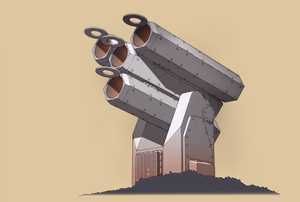
3- The high-energy laser that could take the sting out of drone warfare
Germany
2016 could well be a decisive year for a weapon that might change the dynamics of naval warfare: a high-powered laser capable of shooting down drones or of targeting small surface craft will enter final testing before emerging onto the international market.
Manufactured by Düsseldorf-based Rheinmetall, with some funding from the German government, the MLG27 laser can now be mounted aboard a ship, from where it is capable of hitting slow, small airborne threats such as Unmanned Aerial Vehicles (UAVs). In the past, moist sea air has reduced laser power but this has now been overcome using a revolutionary new technique.
The MLG27 has four 20kw lasers, designed to be fired simultaneously in a configuration known as “superimposition”. Each laser stream is then brought together to combine into a powerful single 80kw beam. In theory, using this technique means there is no limit to how many beams can be focused onto one target; making the weapon more destructive is simply a matter of adding more lasers at the superimposition stage. At low power the beam can disrupt instruments and equipment; at full power it can destroy targets.
The initial cost of the weapon is thought to be high but that outlay is a one-off investment: the “ammunition” is essentially free and unlimited, depending only on the ship producing enough power to regenerate rapidly. Lasers also tend to suffer from less wear and tear, making them cost-effective to run.
In 2014 the US navy demonstrated a ship-borne laser in the Persian Gulf. Rheinmetall has managed to design a far more powerful product and release it to the mass market. It was debuted at the Defence and Security Equipment International exhibition in London in September 2015 and a number of major western navies were reported to be interested.
Under Protocol IV of the Geneva Convention, laser weapons are banned for use against humans. However, as the use and tactical importance of UAVs dramatically increases, the High Energy Laser looks set to play a major role in future conflicts.
Light brigade:
- A laser that is mounted on a warship will enter final testing next year.
- It is capable of shooting down small airborne threats such as Unmanned Aerial Vehicles.
- Using new technology, the laser's four streams are combined to make one powerful beam.
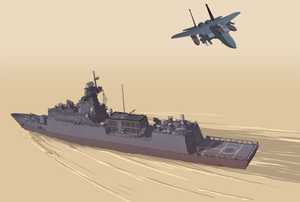
4- The deep-water naval base sending a message to China
The Philippines
The Philippines is responding to Beijing’s moves in the South China Sea by dramatically increasing its defence budget and reopening a strategic naval base. Two new Incheon class frigates will be stationed at the facility to assert the country’s presence in the disputed region. They are multi-role vessels capable of submarine warfare and coastal patrol.
The Philippines government has taken the decision to refurbish and reactivate the massive former US base at Subic Bay, on the edge of the South China Sea. It will be the first time the base has operated since it was closed in 1992, when Manila cancelled an agreement with Washington following the end of the Cold War.
The deep-water harbour will allow any warship currently deployed by the Philippines navy to operate out of Subic Bay, including its new frigates purchased from South Korea. The port is just 145 nautical miles (270km) from Scarborough Shoal, the sandbank that the Chinese seized in 2012. That proximity would allow the Philippines to station surveillance drones in the region to watch Chinese movements around the clock. And the new South Korean-built FA-50 attack aircraft could be over the area within minutes.
Manila’s defence budget in 2016 will be five times that of 2013, reflecting concerns over Chinese foreign policy in the region. Although that represents a significant leap in spending, it will equate to just 0.5 per cent of what China spends on its military – a stark demonstration of the gulf in power. The Philippines has suffered from having a relatively weak military in recent years and its navy has borne the brunt of underfunding as the government strengthened the army to take on internal guerrilla factions. The administration is now addressing its naval weakness as China grows more expansive.
Recently the Philippines navy has been active in the South China Sea, taking part in joint exercises with the US and Japan. Washington, which has been helping Manila improve its military capability, will seek greater access to the renovated facility, not least because its ships could use the port for refuelling and maintenance.
Sea change:
- The Philippines will reopen a massive naval base to counter Beijing's South China Sea moves.
- Subic Bay has a deep-water harbour and is only 270km from the disputed Scarborough Shoal area.
- Two new frigates will be stationed at the base along with a squadron of fighter jets.
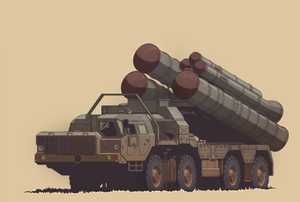
5- The surface-to-air missiles that could change the dynamic in the Middle East
Iran
The lifting of sanctions against Iran following the recent nuclear deal has allowed Russia to agree a contract to supply the Islamic Republic with S-300 surface-to-air missiles. Although technical details are still being discussed, Iran could receive the first batch in early 2016. Their arrival would change the dynamic in the Middle East and potentially embolden Iran in its regional ambitions, to the concern of the Gulf states.
The system could be useful in protecting nuclear sites; as well as targeting aircraft, Iran would be able to engage incoming ballistic missiles for the first time. That capability is one reason Saudi Arabia, Israel and the US all oppose the sale, knowing it will blunt the military superiority they currently enjoy.
Iran’s current air defences suffer coverage gaps, leaving it weak in places. The S-300, whichever variant is eventually settled on, would considerably improve that capability. Although the US might look to call on technical intelligence from allies who use the S-300 system, such as Greece and Ukraine, it would undoubtedly make a pre-emptive strike on an Iranian nuclear target far more risky and costly.
Comparable to the US Patriot missile system, a single S-300 battery can fire at multiple targets up to 27km high, making it one of the world’s most potent anti-aircraft systems.
The €750m contract was first signed in 2007 but Moscow voluntarily suspended it in 2010, following the imposition of sanctions on Iran and pressure from the US. That led Iran to pursue a €3.7bn claim against Russia for breach of contract. But this is a valuable deal for Moscow and so, despite protestations from the West, president Vladimir Putin retracted the ban in April 2015.
The sale is consistent with Putin’s recent foreign-policy direction and underscores how little Moscow is willing to take Washington’s views into account when dealing with Iran. It is also a demonstration that the Kremlin is determined to play tough with a US administration that has one foot out of the door.
Defensive play
- Russia is expected to supply Iran with the S-300 missile system after sanctions against Tehran were lifted.
- It will give the Iranians better airspace coverage and make aerial attacks riskier for enemies.
- One battery can hit multiple targets at altitudes of up to 27,000 metres.

